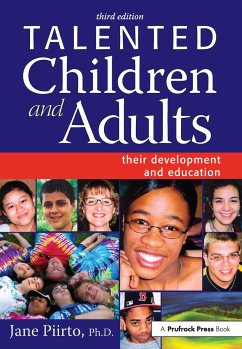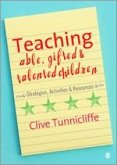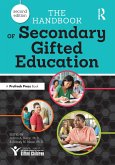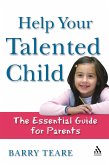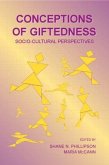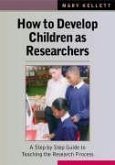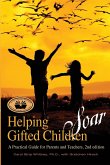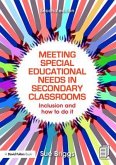- Broschiertes Buch
- Merkliste
- Auf die Merkliste
- Bewerten Bewerten
- Teilen
- Produkt teilen
- Produkterinnerung
- Produkterinnerung
This third edition of the widely popular Talented Children and Adults: Their Development and Education has been revised to include the most up-to-date information on talent development. Written by a nationally recognized author in the field of gifted education, this textbook explores the factors that encourage talent development from birth t
Andere Kunden interessierten sich auch für
![Teaching Able, Gifted and Talented Children Teaching Able, Gifted and Talented Children]() Clive TunnicliffeTeaching Able, Gifted and Talented Children180,99 €
Clive TunnicliffeTeaching Able, Gifted and Talented Children180,99 €![The Handbook of Secondary Gifted Education The Handbook of Secondary Gifted Education]() The Handbook of Secondary Gifted Education99,99 €
The Handbook of Secondary Gifted Education99,99 €![Help Your Talented Child Help Your Talented Child]() Barry TeareHelp Your Talented Child18,99 €
Barry TeareHelp Your Talented Child18,99 €![Conceptions of Giftedness Conceptions of Giftedness]() Conceptions of Giftedness85,99 €
Conceptions of Giftedness85,99 €![How to Develop Children as Researchers How to Develop Children as Researchers]() Mary KellettHow to Develop Children as Researchers63,99 €
Mary KellettHow to Develop Children as Researchers63,99 €![Helping Gifted Children Soar Helping Gifted Children Soar]() Carol Strip WhitneyHelping Gifted Children Soar18,99 €
Carol Strip WhitneyHelping Gifted Children Soar18,99 €![Meeting Special Educational Needs in Secondary Classrooms Meeting Special Educational Needs in Secondary Classrooms]() Sue BriggsMeeting Special Educational Needs in Secondary Classrooms45,99 €
Sue BriggsMeeting Special Educational Needs in Secondary Classrooms45,99 €-
-
-
This third edition of the widely popular Talented Children and Adults: Their Development and Education has been revised to include the most up-to-date information on talent development. Written by a nationally recognized author in the field of gifted education, this textbook explores the factors that encourage talent development from birth t
Hinweis: Dieser Artikel kann nur an eine deutsche Lieferadresse ausgeliefert werden.
Hinweis: Dieser Artikel kann nur an eine deutsche Lieferadresse ausgeliefert werden.
Produktdetails
- Produktdetails
- Verlag: Taylor & Francis Ltd (Sales)
- Revised edition
- Seitenzahl: 752
- Erscheinungstermin: 15. Oktober 2006
- Englisch
- Gewicht: 1387g
- ISBN-13: 9781593632120
- ISBN-10: 1593632126
- Artikelnr.: 35653954
- Herstellerkennzeichnung
- Libri GmbH
- Europaallee 1
- 36244 Bad Hersfeld
- gpsr@libri.de
- Verlag: Taylor & Francis Ltd (Sales)
- Revised edition
- Seitenzahl: 752
- Erscheinungstermin: 15. Oktober 2006
- Englisch
- Gewicht: 1387g
- ISBN-13: 9781593632120
- ISBN-10: 1593632126
- Artikelnr.: 35653954
- Herstellerkennzeichnung
- Libri GmbH
- Europaallee 1
- 36244 Bad Hersfeld
- gpsr@libri.de
Besides this book, currently in its third edition, Jane Piirto is the author of Understanding Those Who Create (two editions); Understanding Creativity; Luovuus; "My Teeming Brain": Understanding Creative Writers; A Location in the Upper Peninsula (collected poems, stories, and essays); The Three-Week Trance Diet (novel); Postcards from the Upper Peninsula, and several poetry and prose chapbooks. An award-winning poet, novelist, and scholar, she is a Trustees' Professor at Ashland University in Ohio, where she is Director of Talent Development Education. She is a former member of the board of directors of the National Association for Gifted Children, and has been in the field of the education of the gifted and talented since 1977 as a program coordinator, principal of the Hunter College Elementary School in New York City, and teacher trainer. She is a national and international speaker and consultant. In August of 2007, Dr. Jane Piirto was awarded the Lifetime Achievement Award by the Mensa Education and Research Foundation. The award, only the fifth given, recognizes outstanding professionals who have contributed a lifetime to scholarly pursuits in intelligence, giftedness, or creativity.
Chapter 1 Who Are the Talented? Giftedness, Talent, and Intelligence School
Definitions of Giftedness The Marland Report 8 1988: The Javits Gifted and
Talented Act National Excellence: A New School Definition of Giftedness No
Child Left Behind History of Intelligence Testing The g Factor Use of the
IQ to Sort and Discriminate Definitions of Intelligence More on General
Intelligence (g) Fluid and Crystallized Intelligence: Hierarchical and
Taxonomic Theories of Intelligence The Lumpers and the Splitters Heredity
or Environment? Darwin and Galton and the Statistical Average What Twin and
Adoptive Studies Have Shown About the Heritability of Intelligence
Definitions of Giftedness and Talent Etymology of the Word Gifted Issues of
Labeling The Social Construction of Giftedness Etymology of the Word
Talented Influential Theories of Giftedness, Talent Development, and
Intelligence A Need for a Theory-Based Definition A New Paradigm
Developmental Theories of Intelligence Cognitive Theories of Intelligence
Comprehensive Theories Psychosocial Theories The Pyramid (Piiramid) of
Talent Development The Genetic Aspect The Emotional Aspect: Personality
Attributes The Cognitive Aspect The Talent Aspect: Talent in Domains
Environmental "Suns" Talent Multipotentiality: Feeling the Call, or the
"Thorn" Need for a New Giftedness Construct A Proposed Giftedness Construct
Case Example: Using the Pyramid of Talent Development in the Inclusionary
Classroom Summary End Notes Chapter 2 Getting Started: Developing a Program
for the Talented The Need for Awareness History of the Education of the
Talented in the U.S. Typical Historical Arrangements for Talented Children
Acceleration Grouping Special Schools Zeitgeist and the Education of the
Talented State of the States The Law and Academically Talented Students
Setting Up a Program The Planning Committee The Necessity of Collaboration
Between General Education and Talent Development Education A Program and
Not a Provision Standards-Based Education for High-Ability Students
Educational Program Options Ability Grouping Acceleration/Enrichment
Cooperative Learning Flexible Grouping Teaching, Waiting, and Helping
Pull-Out or Self-Contained? Regular Classroom Modifications Resource Rooms
Self-Contained Classes and Special Schools Inclusion, Intervention,
Consultation, Facilitation Teachers of the Gifted and Talented Program
Evaluation Using Longitudinal Data for Evaluation Case Example: Four Years
as a Consulting Teacher for the Gifted and Talented Summary Contents
Chapter 3 Identification of the Academically Gifted and Talented: High-IQ
Talent and Specific Academic Talent Identifying and Serving the
Academically Gifted and Talented The Principles and Challenges of
Identification The Need for a Guiding Theory Conflicts Between Theory and
Practice Multiple Means of Identification Proficiency Tests Behavioral
Checklists Superior Documented Performance The Use of Matrices Use of
Multiple Means Can Be Discriminatory The Use of Standard Scores The Use of
Local Norms in Identification Identifying Personality Variables Once
Identified, Always Identified? The Steps of Identification Alternative and
Authentic Means of Nomination and Screening Effectiveness and Efficiency
The Hazards and Benefits of Teacher Nomination The IQ Test IQ Tests and
Socioeconomic Status (SES) Can We Change a Person's IQ? When to Use an IQ
Test Issues of Equity and Testing The Identification of Academic Ability
Group Tests Used for Screening Deviation IQs Proficiency Tests Redux
Spatial Ability Criteria for Standardized Test Selection and Standards for
Testing Is the Test Valid and Reliable? Are There Adequate Ceilings?
Authentic Assessment Standards for Teachers Who Use Tests Identification of
Predictive Behaviors Leisure and Out-of-School Activities as Predictive
Behaviors Case Example: José Summary Chapter 4 Identification of Creativity
History of Creativity Training The Necessity of Practice Educators'
Interest in Creativity The Place of Creativity in Education Teachers and
Parents Enhancing Creativity Creativity Research That Has Influenced the
Field of Talent Development Education The Separation of Creativity From
Talent Renzulli's Definition The Existence of a Creativity Ability Training
for Divergent Production Creativity Training Systems Teachers Benefit From
Creativity Training A Creativity Course Based on What Creators Really Do
Creativity Assessment Reasons for Measuring Creativity Motive to Create
Evaluating Creativity Assessment Instruments Studies of Significant Results
The Normal Curve Assumption Checklists and Questionnaires Promising
Alternative Assessment Practices Interrater Reliability on Storytelling
Performance Criteria Observation of Creativity Identification of Creative
Thinking Ability Identifying Creative Potential by Product Assessment
Portfolios Case Example: Creativity, Inc.: A Program for Developing
Creativity in Adolescents Summary Part II Paths of Talent Development
Chapter 5 The Young Talented Child From Birth to Grade 2 Characteristics of
Young Academically Talented Children Early Reading Cognitive Leaps in Very
High-IQ Children Characteristics in Infancy Characteristics of Toddlers
Mathematical Ability Dyssynchrony Factors That Enhance or Inhibit Young
High-IQ Talent Intensities (Overexcitabilities) as Characteristic of Young
Gifted Children Identification of Young Academically Talented Children The
Hunter College Elementary School Identification System Identification
Through Already-Used Screening Methods The Project Spectrum MI Model of
Identification Javits Projects: Alternative Ways to Identify The Case
Method for Identifying Extremely Economically Poor Students DISCOVER
Assessment Choosing a School Curricula for Young Academically Talented
Children Preschool Curricular Scope for Academically Talented Children
Preschool and Kindergarten Curricular Scope First Grade Curricular Scope
Case Example: A Plan for Scott Summary Chapter 6 The Elementary and Middle
School Talented Child Predictive Behaviors and Commonly Observed
Characteristics of High-IQ Children A Paradigm Shift Children Talented in
Science Fliegler's Checklist Biographical Examples of Elementary-Age
Science Ability Children Talented in Mathematics Biographical Examples of
Elementary-Age Mathematical Ability Inventors as Children Businessmen and
Entrepreneurs as Children Children Talented in Writing Prose Talent
Biographical Indicators of Verbal Talent Children Talented in Visual Arts
Characteristics of Artwork of Children Talented in Visual Arts
Identification of Children Talented in Visual Arts Children Talented in
Music Japanese and Chinese Views of Musical Ability Characteristics of
Music Talent in Children Examples and Studies of Musical Talent Children
Talented in Acting and Dancing Actors as Children Dancers as Children
Identification of Students With Arts Talents Summary Gender Differences in
Talent Development The Middle School Challenge Case Example: The School,
the Parents, and the Girl Summary Chapter 7 High School and College Gifted
and Talented Youth High Scorers on the SAT and ACT Cognitive Components of
High Ability Personality Attributes of Gifted and Talented Teenagers
Personality Testing and Gifted and Talented Adolescents Myers-Briggs Type
Indicator (MBTI) and Talented Adolescents Domain-Specific Talents Academic
Strengths, Interests, and Self-Concept The Importance of Extracurricular
Activities Family Background of Students With Talent Behavioral Rating
Scales Science Talent Development Characteristics of Scientists
Biographical Example of Science Talent Development-Albert Einstein Other
Studies of Scientists Importance of Mentors in Science Women in Science
Mathematics Talent Development Verbal Talent Development Performance Talent
Development Development of Adolescent Musicians Development of Adolescent
Dancers Development of Actors Development of Athletes Visual Arts Talent
Development Leadership Talent Development The Importance of Practical
(Tacit) Knowledge Case Example: Predictive Behaviors and Crystallizing
Experiences in Three Artistic Male College Students Summary Chapter 8
Talented Adults Longitudinal and Follow-Up Studies of High-IQ and
Academically Talented Adults The Terman Study The Hollingworth Group The
Freeman Follow-Up Study What Makes for Eminence? The Quantitative Work of
Dean Keith Simonton Adult Talent Development by Domain Multipotentiality
Myers-Briggs Type Indicator Personality Preferences of Talented Adults
Adult Characteristics of People With Science Talent Adult Research
Neurologists Adult Characteristics of People With Mathematical Talent Math
Olympians Studies of Talented Women Creative Female Mathematicians Social
Science Talent: Creative Women Psychologists Longitudinal Studies of
Talented Women The Path of Adult Creative Writers The Path of Adult Visual
Artists The Path of Adult Musicians and Composers Other Studies of Adults
The Importance of Mentors Fulfillment of Potential, Life Satisfaction, and
Competence in Women Fulfillment of Potential, Life Satisfaction, and
Competence in Men The Blurring of Traditional Gender Lines in Adulthood
Consequences of Being a Gifted and Talented Adult Spiritual Growth Case
Example: Engineer as High School Teacher Summary Part III Curriculum,
Counseling, and At-Risk Talented Students Chapter 9 Precepts for Curriculum
for the Academically Talented A Definition of Curriculum Differentiation
Precept 1: Base Curriculum on Learning Characteristics of the Academically
Talented Students in Their Areas of Strength Pace Depth Learning Through
Reading Precept 2: Strive for Academic Rigor in the Curriculum Assessment
in the Context of Academic Rigor The "Dumbed-Down" Curriculum What the
TIMSS Studies Showed Academic Rigor: Alternative Assessment High School
Graduation Outcomes Precept 3: Plan Thematic and Interdisciplinary
Curricula Precept 4: Five Curriculum Orientations Should Be Considered
Curriculum as Personal Relevance Curriculum as Technology Curriculum as
Academic Rationalism Curriculum as Social Adaptation and Social
Reconstruction Curriculum as the Development of Cognitive Processes Precept
5: Plan a Balanced and Articulated Curriculum General Education and Gifted
Education Case Example: Twelve Issues: Implications of Postmodern
Curriculum Theory for The Education of the Talented Summary Chapter 10
Curriculum Practices: In and Out of the Classroom Principles of Curriculum
Development Differentiation as a Result of Different Interests Independent
Study as Differentiation Differentiation in Pace Differentiation in Depth
Guidance Issues for Talented Youth Course Taking Acceleration Career
Development Finding Mentors Multipotentiality Differences Between Highly
Talented and Moderately Talented Learning Styles of Talented Youth Concerns
About Learning Style Theorizing Brain-Based Learning Testing Program
Articulation Vocational Guidance Volunteerism and Service Gender Difference
Concerns for Guidance Intervention Gender Differences in Testing Counseling
Issues Among Talented Youth Anger Attention Disorders and Other Medical
Conditions Genuine Boredom Bullying Creativity Delinquency Depression
Dropping Out of School Gender-Related Issues Very High IQ Introversion
Intuition Meeting the Expectations of Others Motivation Overexcitabilities:
The Dabrowski Theory and Emotional Intensity Peer Relations Perfectionism
and the Talented Overachievement Resilience and Its Relationship to
Achievement Self-Concept/Self-Esteem Stress Sexual Identity
Underachievement An Individual and Group Educational Guidance Plan (IEP)
Conclusion Case Example: Judith Resnik Summary Chapter 12 Children of the
American Dream: Populations of Talented Children Who Need Special Attention
Definitions of "At Risk" and the Challenge of Identification Multicultural
Assessment and Identification The Challenge of Identification
Identification Rural Students Students From Low-Income Families Urban
Students English-Speaking Students From Various Racial Backgrounds African
Americans American Indians Students With Limited English Proficiency (LEP)
Hispanics (Latinos) Pacific Islanders and Asians: Emerging Minorities Other
Immigrants Students With Physical or Learning Disabilities Talented
Children With Learning Disabilities Talented Children With Physical
Disabilities ADHD/ADD and the Gifted and Talented Students From Troubled
Family Situations Students Possessing a Combination of Characteristics Case
Example: Charlayne Hunter-Gault, Civil-Rights Heroine Summary Appendix:
Comparison of Standardized Tests References Name Index Subject Index About
the Author
Definitions of Giftedness The Marland Report 8 1988: The Javits Gifted and
Talented Act National Excellence: A New School Definition of Giftedness No
Child Left Behind History of Intelligence Testing The g Factor Use of the
IQ to Sort and Discriminate Definitions of Intelligence More on General
Intelligence (g) Fluid and Crystallized Intelligence: Hierarchical and
Taxonomic Theories of Intelligence The Lumpers and the Splitters Heredity
or Environment? Darwin and Galton and the Statistical Average What Twin and
Adoptive Studies Have Shown About the Heritability of Intelligence
Definitions of Giftedness and Talent Etymology of the Word Gifted Issues of
Labeling The Social Construction of Giftedness Etymology of the Word
Talented Influential Theories of Giftedness, Talent Development, and
Intelligence A Need for a Theory-Based Definition A New Paradigm
Developmental Theories of Intelligence Cognitive Theories of Intelligence
Comprehensive Theories Psychosocial Theories The Pyramid (Piiramid) of
Talent Development The Genetic Aspect The Emotional Aspect: Personality
Attributes The Cognitive Aspect The Talent Aspect: Talent in Domains
Environmental "Suns" Talent Multipotentiality: Feeling the Call, or the
"Thorn" Need for a New Giftedness Construct A Proposed Giftedness Construct
Case Example: Using the Pyramid of Talent Development in the Inclusionary
Classroom Summary End Notes Chapter 2 Getting Started: Developing a Program
for the Talented The Need for Awareness History of the Education of the
Talented in the U.S. Typical Historical Arrangements for Talented Children
Acceleration Grouping Special Schools Zeitgeist and the Education of the
Talented State of the States The Law and Academically Talented Students
Setting Up a Program The Planning Committee The Necessity of Collaboration
Between General Education and Talent Development Education A Program and
Not a Provision Standards-Based Education for High-Ability Students
Educational Program Options Ability Grouping Acceleration/Enrichment
Cooperative Learning Flexible Grouping Teaching, Waiting, and Helping
Pull-Out or Self-Contained? Regular Classroom Modifications Resource Rooms
Self-Contained Classes and Special Schools Inclusion, Intervention,
Consultation, Facilitation Teachers of the Gifted and Talented Program
Evaluation Using Longitudinal Data for Evaluation Case Example: Four Years
as a Consulting Teacher for the Gifted and Talented Summary Contents
Chapter 3 Identification of the Academically Gifted and Talented: High-IQ
Talent and Specific Academic Talent Identifying and Serving the
Academically Gifted and Talented The Principles and Challenges of
Identification The Need for a Guiding Theory Conflicts Between Theory and
Practice Multiple Means of Identification Proficiency Tests Behavioral
Checklists Superior Documented Performance The Use of Matrices Use of
Multiple Means Can Be Discriminatory The Use of Standard Scores The Use of
Local Norms in Identification Identifying Personality Variables Once
Identified, Always Identified? The Steps of Identification Alternative and
Authentic Means of Nomination and Screening Effectiveness and Efficiency
The Hazards and Benefits of Teacher Nomination The IQ Test IQ Tests and
Socioeconomic Status (SES) Can We Change a Person's IQ? When to Use an IQ
Test Issues of Equity and Testing The Identification of Academic Ability
Group Tests Used for Screening Deviation IQs Proficiency Tests Redux
Spatial Ability Criteria for Standardized Test Selection and Standards for
Testing Is the Test Valid and Reliable? Are There Adequate Ceilings?
Authentic Assessment Standards for Teachers Who Use Tests Identification of
Predictive Behaviors Leisure and Out-of-School Activities as Predictive
Behaviors Case Example: José Summary Chapter 4 Identification of Creativity
History of Creativity Training The Necessity of Practice Educators'
Interest in Creativity The Place of Creativity in Education Teachers and
Parents Enhancing Creativity Creativity Research That Has Influenced the
Field of Talent Development Education The Separation of Creativity From
Talent Renzulli's Definition The Existence of a Creativity Ability Training
for Divergent Production Creativity Training Systems Teachers Benefit From
Creativity Training A Creativity Course Based on What Creators Really Do
Creativity Assessment Reasons for Measuring Creativity Motive to Create
Evaluating Creativity Assessment Instruments Studies of Significant Results
The Normal Curve Assumption Checklists and Questionnaires Promising
Alternative Assessment Practices Interrater Reliability on Storytelling
Performance Criteria Observation of Creativity Identification of Creative
Thinking Ability Identifying Creative Potential by Product Assessment
Portfolios Case Example: Creativity, Inc.: A Program for Developing
Creativity in Adolescents Summary Part II Paths of Talent Development
Chapter 5 The Young Talented Child From Birth to Grade 2 Characteristics of
Young Academically Talented Children Early Reading Cognitive Leaps in Very
High-IQ Children Characteristics in Infancy Characteristics of Toddlers
Mathematical Ability Dyssynchrony Factors That Enhance or Inhibit Young
High-IQ Talent Intensities (Overexcitabilities) as Characteristic of Young
Gifted Children Identification of Young Academically Talented Children The
Hunter College Elementary School Identification System Identification
Through Already-Used Screening Methods The Project Spectrum MI Model of
Identification Javits Projects: Alternative Ways to Identify The Case
Method for Identifying Extremely Economically Poor Students DISCOVER
Assessment Choosing a School Curricula for Young Academically Talented
Children Preschool Curricular Scope for Academically Talented Children
Preschool and Kindergarten Curricular Scope First Grade Curricular Scope
Case Example: A Plan for Scott Summary Chapter 6 The Elementary and Middle
School Talented Child Predictive Behaviors and Commonly Observed
Characteristics of High-IQ Children A Paradigm Shift Children Talented in
Science Fliegler's Checklist Biographical Examples of Elementary-Age
Science Ability Children Talented in Mathematics Biographical Examples of
Elementary-Age Mathematical Ability Inventors as Children Businessmen and
Entrepreneurs as Children Children Talented in Writing Prose Talent
Biographical Indicators of Verbal Talent Children Talented in Visual Arts
Characteristics of Artwork of Children Talented in Visual Arts
Identification of Children Talented in Visual Arts Children Talented in
Music Japanese and Chinese Views of Musical Ability Characteristics of
Music Talent in Children Examples and Studies of Musical Talent Children
Talented in Acting and Dancing Actors as Children Dancers as Children
Identification of Students With Arts Talents Summary Gender Differences in
Talent Development The Middle School Challenge Case Example: The School,
the Parents, and the Girl Summary Chapter 7 High School and College Gifted
and Talented Youth High Scorers on the SAT and ACT Cognitive Components of
High Ability Personality Attributes of Gifted and Talented Teenagers
Personality Testing and Gifted and Talented Adolescents Myers-Briggs Type
Indicator (MBTI) and Talented Adolescents Domain-Specific Talents Academic
Strengths, Interests, and Self-Concept The Importance of Extracurricular
Activities Family Background of Students With Talent Behavioral Rating
Scales Science Talent Development Characteristics of Scientists
Biographical Example of Science Talent Development-Albert Einstein Other
Studies of Scientists Importance of Mentors in Science Women in Science
Mathematics Talent Development Verbal Talent Development Performance Talent
Development Development of Adolescent Musicians Development of Adolescent
Dancers Development of Actors Development of Athletes Visual Arts Talent
Development Leadership Talent Development The Importance of Practical
(Tacit) Knowledge Case Example: Predictive Behaviors and Crystallizing
Experiences in Three Artistic Male College Students Summary Chapter 8
Talented Adults Longitudinal and Follow-Up Studies of High-IQ and
Academically Talented Adults The Terman Study The Hollingworth Group The
Freeman Follow-Up Study What Makes for Eminence? The Quantitative Work of
Dean Keith Simonton Adult Talent Development by Domain Multipotentiality
Myers-Briggs Type Indicator Personality Preferences of Talented Adults
Adult Characteristics of People With Science Talent Adult Research
Neurologists Adult Characteristics of People With Mathematical Talent Math
Olympians Studies of Talented Women Creative Female Mathematicians Social
Science Talent: Creative Women Psychologists Longitudinal Studies of
Talented Women The Path of Adult Creative Writers The Path of Adult Visual
Artists The Path of Adult Musicians and Composers Other Studies of Adults
The Importance of Mentors Fulfillment of Potential, Life Satisfaction, and
Competence in Women Fulfillment of Potential, Life Satisfaction, and
Competence in Men The Blurring of Traditional Gender Lines in Adulthood
Consequences of Being a Gifted and Talented Adult Spiritual Growth Case
Example: Engineer as High School Teacher Summary Part III Curriculum,
Counseling, and At-Risk Talented Students Chapter 9 Precepts for Curriculum
for the Academically Talented A Definition of Curriculum Differentiation
Precept 1: Base Curriculum on Learning Characteristics of the Academically
Talented Students in Their Areas of Strength Pace Depth Learning Through
Reading Precept 2: Strive for Academic Rigor in the Curriculum Assessment
in the Context of Academic Rigor The "Dumbed-Down" Curriculum What the
TIMSS Studies Showed Academic Rigor: Alternative Assessment High School
Graduation Outcomes Precept 3: Plan Thematic and Interdisciplinary
Curricula Precept 4: Five Curriculum Orientations Should Be Considered
Curriculum as Personal Relevance Curriculum as Technology Curriculum as
Academic Rationalism Curriculum as Social Adaptation and Social
Reconstruction Curriculum as the Development of Cognitive Processes Precept
5: Plan a Balanced and Articulated Curriculum General Education and Gifted
Education Case Example: Twelve Issues: Implications of Postmodern
Curriculum Theory for The Education of the Talented Summary Chapter 10
Curriculum Practices: In and Out of the Classroom Principles of Curriculum
Development Differentiation as a Result of Different Interests Independent
Study as Differentiation Differentiation in Pace Differentiation in Depth
Guidance Issues for Talented Youth Course Taking Acceleration Career
Development Finding Mentors Multipotentiality Differences Between Highly
Talented and Moderately Talented Learning Styles of Talented Youth Concerns
About Learning Style Theorizing Brain-Based Learning Testing Program
Articulation Vocational Guidance Volunteerism and Service Gender Difference
Concerns for Guidance Intervention Gender Differences in Testing Counseling
Issues Among Talented Youth Anger Attention Disorders and Other Medical
Conditions Genuine Boredom Bullying Creativity Delinquency Depression
Dropping Out of School Gender-Related Issues Very High IQ Introversion
Intuition Meeting the Expectations of Others Motivation Overexcitabilities:
The Dabrowski Theory and Emotional Intensity Peer Relations Perfectionism
and the Talented Overachievement Resilience and Its Relationship to
Achievement Self-Concept/Self-Esteem Stress Sexual Identity
Underachievement An Individual and Group Educational Guidance Plan (IEP)
Conclusion Case Example: Judith Resnik Summary Chapter 12 Children of the
American Dream: Populations of Talented Children Who Need Special Attention
Definitions of "At Risk" and the Challenge of Identification Multicultural
Assessment and Identification The Challenge of Identification
Identification Rural Students Students From Low-Income Families Urban
Students English-Speaking Students From Various Racial Backgrounds African
Americans American Indians Students With Limited English Proficiency (LEP)
Hispanics (Latinos) Pacific Islanders and Asians: Emerging Minorities Other
Immigrants Students With Physical or Learning Disabilities Talented
Children With Learning Disabilities Talented Children With Physical
Disabilities ADHD/ADD and the Gifted and Talented Students From Troubled
Family Situations Students Possessing a Combination of Characteristics Case
Example: Charlayne Hunter-Gault, Civil-Rights Heroine Summary Appendix:
Comparison of Standardized Tests References Name Index Subject Index About
the Author
Chapter 1 Who Are the Talented? Giftedness, Talent, and Intelligence School
Definitions of Giftedness The Marland Report 8 1988: The Javits Gifted and
Talented Act National Excellence: A New School Definition of Giftedness No
Child Left Behind History of Intelligence Testing The g Factor Use of the
IQ to Sort and Discriminate Definitions of Intelligence More on General
Intelligence (g) Fluid and Crystallized Intelligence: Hierarchical and
Taxonomic Theories of Intelligence The Lumpers and the Splitters Heredity
or Environment? Darwin and Galton and the Statistical Average What Twin and
Adoptive Studies Have Shown About the Heritability of Intelligence
Definitions of Giftedness and Talent Etymology of the Word Gifted Issues of
Labeling The Social Construction of Giftedness Etymology of the Word
Talented Influential Theories of Giftedness, Talent Development, and
Intelligence A Need for a Theory-Based Definition A New Paradigm
Developmental Theories of Intelligence Cognitive Theories of Intelligence
Comprehensive Theories Psychosocial Theories The Pyramid (Piiramid) of
Talent Development The Genetic Aspect The Emotional Aspect: Personality
Attributes The Cognitive Aspect The Talent Aspect: Talent in Domains
Environmental "Suns" Talent Multipotentiality: Feeling the Call, or the
"Thorn" Need for a New Giftedness Construct A Proposed Giftedness Construct
Case Example: Using the Pyramid of Talent Development in the Inclusionary
Classroom Summary End Notes Chapter 2 Getting Started: Developing a Program
for the Talented The Need for Awareness History of the Education of the
Talented in the U.S. Typical Historical Arrangements for Talented Children
Acceleration Grouping Special Schools Zeitgeist and the Education of the
Talented State of the States The Law and Academically Talented Students
Setting Up a Program The Planning Committee The Necessity of Collaboration
Between General Education and Talent Development Education A Program and
Not a Provision Standards-Based Education for High-Ability Students
Educational Program Options Ability Grouping Acceleration/Enrichment
Cooperative Learning Flexible Grouping Teaching, Waiting, and Helping
Pull-Out or Self-Contained? Regular Classroom Modifications Resource Rooms
Self-Contained Classes and Special Schools Inclusion, Intervention,
Consultation, Facilitation Teachers of the Gifted and Talented Program
Evaluation Using Longitudinal Data for Evaluation Case Example: Four Years
as a Consulting Teacher for the Gifted and Talented Summary Contents
Chapter 3 Identification of the Academically Gifted and Talented: High-IQ
Talent and Specific Academic Talent Identifying and Serving the
Academically Gifted and Talented The Principles and Challenges of
Identification The Need for a Guiding Theory Conflicts Between Theory and
Practice Multiple Means of Identification Proficiency Tests Behavioral
Checklists Superior Documented Performance The Use of Matrices Use of
Multiple Means Can Be Discriminatory The Use of Standard Scores The Use of
Local Norms in Identification Identifying Personality Variables Once
Identified, Always Identified? The Steps of Identification Alternative and
Authentic Means of Nomination and Screening Effectiveness and Efficiency
The Hazards and Benefits of Teacher Nomination The IQ Test IQ Tests and
Socioeconomic Status (SES) Can We Change a Person's IQ? When to Use an IQ
Test Issues of Equity and Testing The Identification of Academic Ability
Group Tests Used for Screening Deviation IQs Proficiency Tests Redux
Spatial Ability Criteria for Standardized Test Selection and Standards for
Testing Is the Test Valid and Reliable? Are There Adequate Ceilings?
Authentic Assessment Standards for Teachers Who Use Tests Identification of
Predictive Behaviors Leisure and Out-of-School Activities as Predictive
Behaviors Case Example: José Summary Chapter 4 Identification of Creativity
History of Creativity Training The Necessity of Practice Educators'
Interest in Creativity The Place of Creativity in Education Teachers and
Parents Enhancing Creativity Creativity Research That Has Influenced the
Field of Talent Development Education The Separation of Creativity From
Talent Renzulli's Definition The Existence of a Creativity Ability Training
for Divergent Production Creativity Training Systems Teachers Benefit From
Creativity Training A Creativity Course Based on What Creators Really Do
Creativity Assessment Reasons for Measuring Creativity Motive to Create
Evaluating Creativity Assessment Instruments Studies of Significant Results
The Normal Curve Assumption Checklists and Questionnaires Promising
Alternative Assessment Practices Interrater Reliability on Storytelling
Performance Criteria Observation of Creativity Identification of Creative
Thinking Ability Identifying Creative Potential by Product Assessment
Portfolios Case Example: Creativity, Inc.: A Program for Developing
Creativity in Adolescents Summary Part II Paths of Talent Development
Chapter 5 The Young Talented Child From Birth to Grade 2 Characteristics of
Young Academically Talented Children Early Reading Cognitive Leaps in Very
High-IQ Children Characteristics in Infancy Characteristics of Toddlers
Mathematical Ability Dyssynchrony Factors That Enhance or Inhibit Young
High-IQ Talent Intensities (Overexcitabilities) as Characteristic of Young
Gifted Children Identification of Young Academically Talented Children The
Hunter College Elementary School Identification System Identification
Through Already-Used Screening Methods The Project Spectrum MI Model of
Identification Javits Projects: Alternative Ways to Identify The Case
Method for Identifying Extremely Economically Poor Students DISCOVER
Assessment Choosing a School Curricula for Young Academically Talented
Children Preschool Curricular Scope for Academically Talented Children
Preschool and Kindergarten Curricular Scope First Grade Curricular Scope
Case Example: A Plan for Scott Summary Chapter 6 The Elementary and Middle
School Talented Child Predictive Behaviors and Commonly Observed
Characteristics of High-IQ Children A Paradigm Shift Children Talented in
Science Fliegler's Checklist Biographical Examples of Elementary-Age
Science Ability Children Talented in Mathematics Biographical Examples of
Elementary-Age Mathematical Ability Inventors as Children Businessmen and
Entrepreneurs as Children Children Talented in Writing Prose Talent
Biographical Indicators of Verbal Talent Children Talented in Visual Arts
Characteristics of Artwork of Children Talented in Visual Arts
Identification of Children Talented in Visual Arts Children Talented in
Music Japanese and Chinese Views of Musical Ability Characteristics of
Music Talent in Children Examples and Studies of Musical Talent Children
Talented in Acting and Dancing Actors as Children Dancers as Children
Identification of Students With Arts Talents Summary Gender Differences in
Talent Development The Middle School Challenge Case Example: The School,
the Parents, and the Girl Summary Chapter 7 High School and College Gifted
and Talented Youth High Scorers on the SAT and ACT Cognitive Components of
High Ability Personality Attributes of Gifted and Talented Teenagers
Personality Testing and Gifted and Talented Adolescents Myers-Briggs Type
Indicator (MBTI) and Talented Adolescents Domain-Specific Talents Academic
Strengths, Interests, and Self-Concept The Importance of Extracurricular
Activities Family Background of Students With Talent Behavioral Rating
Scales Science Talent Development Characteristics of Scientists
Biographical Example of Science Talent Development-Albert Einstein Other
Studies of Scientists Importance of Mentors in Science Women in Science
Mathematics Talent Development Verbal Talent Development Performance Talent
Development Development of Adolescent Musicians Development of Adolescent
Dancers Development of Actors Development of Athletes Visual Arts Talent
Development Leadership Talent Development The Importance of Practical
(Tacit) Knowledge Case Example: Predictive Behaviors and Crystallizing
Experiences in Three Artistic Male College Students Summary Chapter 8
Talented Adults Longitudinal and Follow-Up Studies of High-IQ and
Academically Talented Adults The Terman Study The Hollingworth Group The
Freeman Follow-Up Study What Makes for Eminence? The Quantitative Work of
Dean Keith Simonton Adult Talent Development by Domain Multipotentiality
Myers-Briggs Type Indicator Personality Preferences of Talented Adults
Adult Characteristics of People With Science Talent Adult Research
Neurologists Adult Characteristics of People With Mathematical Talent Math
Olympians Studies of Talented Women Creative Female Mathematicians Social
Science Talent: Creative Women Psychologists Longitudinal Studies of
Talented Women The Path of Adult Creative Writers The Path of Adult Visual
Artists The Path of Adult Musicians and Composers Other Studies of Adults
The Importance of Mentors Fulfillment of Potential, Life Satisfaction, and
Competence in Women Fulfillment of Potential, Life Satisfaction, and
Competence in Men The Blurring of Traditional Gender Lines in Adulthood
Consequences of Being a Gifted and Talented Adult Spiritual Growth Case
Example: Engineer as High School Teacher Summary Part III Curriculum,
Counseling, and At-Risk Talented Students Chapter 9 Precepts for Curriculum
for the Academically Talented A Definition of Curriculum Differentiation
Precept 1: Base Curriculum on Learning Characteristics of the Academically
Talented Students in Their Areas of Strength Pace Depth Learning Through
Reading Precept 2: Strive for Academic Rigor in the Curriculum Assessment
in the Context of Academic Rigor The "Dumbed-Down" Curriculum What the
TIMSS Studies Showed Academic Rigor: Alternative Assessment High School
Graduation Outcomes Precept 3: Plan Thematic and Interdisciplinary
Curricula Precept 4: Five Curriculum Orientations Should Be Considered
Curriculum as Personal Relevance Curriculum as Technology Curriculum as
Academic Rationalism Curriculum as Social Adaptation and Social
Reconstruction Curriculum as the Development of Cognitive Processes Precept
5: Plan a Balanced and Articulated Curriculum General Education and Gifted
Education Case Example: Twelve Issues: Implications of Postmodern
Curriculum Theory for The Education of the Talented Summary Chapter 10
Curriculum Practices: In and Out of the Classroom Principles of Curriculum
Development Differentiation as a Result of Different Interests Independent
Study as Differentiation Differentiation in Pace Differentiation in Depth
Guidance Issues for Talented Youth Course Taking Acceleration Career
Development Finding Mentors Multipotentiality Differences Between Highly
Talented and Moderately Talented Learning Styles of Talented Youth Concerns
About Learning Style Theorizing Brain-Based Learning Testing Program
Articulation Vocational Guidance Volunteerism and Service Gender Difference
Concerns for Guidance Intervention Gender Differences in Testing Counseling
Issues Among Talented Youth Anger Attention Disorders and Other Medical
Conditions Genuine Boredom Bullying Creativity Delinquency Depression
Dropping Out of School Gender-Related Issues Very High IQ Introversion
Intuition Meeting the Expectations of Others Motivation Overexcitabilities:
The Dabrowski Theory and Emotional Intensity Peer Relations Perfectionism
and the Talented Overachievement Resilience and Its Relationship to
Achievement Self-Concept/Self-Esteem Stress Sexual Identity
Underachievement An Individual and Group Educational Guidance Plan (IEP)
Conclusion Case Example: Judith Resnik Summary Chapter 12 Children of the
American Dream: Populations of Talented Children Who Need Special Attention
Definitions of "At Risk" and the Challenge of Identification Multicultural
Assessment and Identification The Challenge of Identification
Identification Rural Students Students From Low-Income Families Urban
Students English-Speaking Students From Various Racial Backgrounds African
Americans American Indians Students With Limited English Proficiency (LEP)
Hispanics (Latinos) Pacific Islanders and Asians: Emerging Minorities Other
Immigrants Students With Physical or Learning Disabilities Talented
Children With Learning Disabilities Talented Children With Physical
Disabilities ADHD/ADD and the Gifted and Talented Students From Troubled
Family Situations Students Possessing a Combination of Characteristics Case
Example: Charlayne Hunter-Gault, Civil-Rights Heroine Summary Appendix:
Comparison of Standardized Tests References Name Index Subject Index About
the Author
Definitions of Giftedness The Marland Report 8 1988: The Javits Gifted and
Talented Act National Excellence: A New School Definition of Giftedness No
Child Left Behind History of Intelligence Testing The g Factor Use of the
IQ to Sort and Discriminate Definitions of Intelligence More on General
Intelligence (g) Fluid and Crystallized Intelligence: Hierarchical and
Taxonomic Theories of Intelligence The Lumpers and the Splitters Heredity
or Environment? Darwin and Galton and the Statistical Average What Twin and
Adoptive Studies Have Shown About the Heritability of Intelligence
Definitions of Giftedness and Talent Etymology of the Word Gifted Issues of
Labeling The Social Construction of Giftedness Etymology of the Word
Talented Influential Theories of Giftedness, Talent Development, and
Intelligence A Need for a Theory-Based Definition A New Paradigm
Developmental Theories of Intelligence Cognitive Theories of Intelligence
Comprehensive Theories Psychosocial Theories The Pyramid (Piiramid) of
Talent Development The Genetic Aspect The Emotional Aspect: Personality
Attributes The Cognitive Aspect The Talent Aspect: Talent in Domains
Environmental "Suns" Talent Multipotentiality: Feeling the Call, or the
"Thorn" Need for a New Giftedness Construct A Proposed Giftedness Construct
Case Example: Using the Pyramid of Talent Development in the Inclusionary
Classroom Summary End Notes Chapter 2 Getting Started: Developing a Program
for the Talented The Need for Awareness History of the Education of the
Talented in the U.S. Typical Historical Arrangements for Talented Children
Acceleration Grouping Special Schools Zeitgeist and the Education of the
Talented State of the States The Law and Academically Talented Students
Setting Up a Program The Planning Committee The Necessity of Collaboration
Between General Education and Talent Development Education A Program and
Not a Provision Standards-Based Education for High-Ability Students
Educational Program Options Ability Grouping Acceleration/Enrichment
Cooperative Learning Flexible Grouping Teaching, Waiting, and Helping
Pull-Out or Self-Contained? Regular Classroom Modifications Resource Rooms
Self-Contained Classes and Special Schools Inclusion, Intervention,
Consultation, Facilitation Teachers of the Gifted and Talented Program
Evaluation Using Longitudinal Data for Evaluation Case Example: Four Years
as a Consulting Teacher for the Gifted and Talented Summary Contents
Chapter 3 Identification of the Academically Gifted and Talented: High-IQ
Talent and Specific Academic Talent Identifying and Serving the
Academically Gifted and Talented The Principles and Challenges of
Identification The Need for a Guiding Theory Conflicts Between Theory and
Practice Multiple Means of Identification Proficiency Tests Behavioral
Checklists Superior Documented Performance The Use of Matrices Use of
Multiple Means Can Be Discriminatory The Use of Standard Scores The Use of
Local Norms in Identification Identifying Personality Variables Once
Identified, Always Identified? The Steps of Identification Alternative and
Authentic Means of Nomination and Screening Effectiveness and Efficiency
The Hazards and Benefits of Teacher Nomination The IQ Test IQ Tests and
Socioeconomic Status (SES) Can We Change a Person's IQ? When to Use an IQ
Test Issues of Equity and Testing The Identification of Academic Ability
Group Tests Used for Screening Deviation IQs Proficiency Tests Redux
Spatial Ability Criteria for Standardized Test Selection and Standards for
Testing Is the Test Valid and Reliable? Are There Adequate Ceilings?
Authentic Assessment Standards for Teachers Who Use Tests Identification of
Predictive Behaviors Leisure and Out-of-School Activities as Predictive
Behaviors Case Example: José Summary Chapter 4 Identification of Creativity
History of Creativity Training The Necessity of Practice Educators'
Interest in Creativity The Place of Creativity in Education Teachers and
Parents Enhancing Creativity Creativity Research That Has Influenced the
Field of Talent Development Education The Separation of Creativity From
Talent Renzulli's Definition The Existence of a Creativity Ability Training
for Divergent Production Creativity Training Systems Teachers Benefit From
Creativity Training A Creativity Course Based on What Creators Really Do
Creativity Assessment Reasons for Measuring Creativity Motive to Create
Evaluating Creativity Assessment Instruments Studies of Significant Results
The Normal Curve Assumption Checklists and Questionnaires Promising
Alternative Assessment Practices Interrater Reliability on Storytelling
Performance Criteria Observation of Creativity Identification of Creative
Thinking Ability Identifying Creative Potential by Product Assessment
Portfolios Case Example: Creativity, Inc.: A Program for Developing
Creativity in Adolescents Summary Part II Paths of Talent Development
Chapter 5 The Young Talented Child From Birth to Grade 2 Characteristics of
Young Academically Talented Children Early Reading Cognitive Leaps in Very
High-IQ Children Characteristics in Infancy Characteristics of Toddlers
Mathematical Ability Dyssynchrony Factors That Enhance or Inhibit Young
High-IQ Talent Intensities (Overexcitabilities) as Characteristic of Young
Gifted Children Identification of Young Academically Talented Children The
Hunter College Elementary School Identification System Identification
Through Already-Used Screening Methods The Project Spectrum MI Model of
Identification Javits Projects: Alternative Ways to Identify The Case
Method for Identifying Extremely Economically Poor Students DISCOVER
Assessment Choosing a School Curricula for Young Academically Talented
Children Preschool Curricular Scope for Academically Talented Children
Preschool and Kindergarten Curricular Scope First Grade Curricular Scope
Case Example: A Plan for Scott Summary Chapter 6 The Elementary and Middle
School Talented Child Predictive Behaviors and Commonly Observed
Characteristics of High-IQ Children A Paradigm Shift Children Talented in
Science Fliegler's Checklist Biographical Examples of Elementary-Age
Science Ability Children Talented in Mathematics Biographical Examples of
Elementary-Age Mathematical Ability Inventors as Children Businessmen and
Entrepreneurs as Children Children Talented in Writing Prose Talent
Biographical Indicators of Verbal Talent Children Talented in Visual Arts
Characteristics of Artwork of Children Talented in Visual Arts
Identification of Children Talented in Visual Arts Children Talented in
Music Japanese and Chinese Views of Musical Ability Characteristics of
Music Talent in Children Examples and Studies of Musical Talent Children
Talented in Acting and Dancing Actors as Children Dancers as Children
Identification of Students With Arts Talents Summary Gender Differences in
Talent Development The Middle School Challenge Case Example: The School,
the Parents, and the Girl Summary Chapter 7 High School and College Gifted
and Talented Youth High Scorers on the SAT and ACT Cognitive Components of
High Ability Personality Attributes of Gifted and Talented Teenagers
Personality Testing and Gifted and Talented Adolescents Myers-Briggs Type
Indicator (MBTI) and Talented Adolescents Domain-Specific Talents Academic
Strengths, Interests, and Self-Concept The Importance of Extracurricular
Activities Family Background of Students With Talent Behavioral Rating
Scales Science Talent Development Characteristics of Scientists
Biographical Example of Science Talent Development-Albert Einstein Other
Studies of Scientists Importance of Mentors in Science Women in Science
Mathematics Talent Development Verbal Talent Development Performance Talent
Development Development of Adolescent Musicians Development of Adolescent
Dancers Development of Actors Development of Athletes Visual Arts Talent
Development Leadership Talent Development The Importance of Practical
(Tacit) Knowledge Case Example: Predictive Behaviors and Crystallizing
Experiences in Three Artistic Male College Students Summary Chapter 8
Talented Adults Longitudinal and Follow-Up Studies of High-IQ and
Academically Talented Adults The Terman Study The Hollingworth Group The
Freeman Follow-Up Study What Makes for Eminence? The Quantitative Work of
Dean Keith Simonton Adult Talent Development by Domain Multipotentiality
Myers-Briggs Type Indicator Personality Preferences of Talented Adults
Adult Characteristics of People With Science Talent Adult Research
Neurologists Adult Characteristics of People With Mathematical Talent Math
Olympians Studies of Talented Women Creative Female Mathematicians Social
Science Talent: Creative Women Psychologists Longitudinal Studies of
Talented Women The Path of Adult Creative Writers The Path of Adult Visual
Artists The Path of Adult Musicians and Composers Other Studies of Adults
The Importance of Mentors Fulfillment of Potential, Life Satisfaction, and
Competence in Women Fulfillment of Potential, Life Satisfaction, and
Competence in Men The Blurring of Traditional Gender Lines in Adulthood
Consequences of Being a Gifted and Talented Adult Spiritual Growth Case
Example: Engineer as High School Teacher Summary Part III Curriculum,
Counseling, and At-Risk Talented Students Chapter 9 Precepts for Curriculum
for the Academically Talented A Definition of Curriculum Differentiation
Precept 1: Base Curriculum on Learning Characteristics of the Academically
Talented Students in Their Areas of Strength Pace Depth Learning Through
Reading Precept 2: Strive for Academic Rigor in the Curriculum Assessment
in the Context of Academic Rigor The "Dumbed-Down" Curriculum What the
TIMSS Studies Showed Academic Rigor: Alternative Assessment High School
Graduation Outcomes Precept 3: Plan Thematic and Interdisciplinary
Curricula Precept 4: Five Curriculum Orientations Should Be Considered
Curriculum as Personal Relevance Curriculum as Technology Curriculum as
Academic Rationalism Curriculum as Social Adaptation and Social
Reconstruction Curriculum as the Development of Cognitive Processes Precept
5: Plan a Balanced and Articulated Curriculum General Education and Gifted
Education Case Example: Twelve Issues: Implications of Postmodern
Curriculum Theory for The Education of the Talented Summary Chapter 10
Curriculum Practices: In and Out of the Classroom Principles of Curriculum
Development Differentiation as a Result of Different Interests Independent
Study as Differentiation Differentiation in Pace Differentiation in Depth
Guidance Issues for Talented Youth Course Taking Acceleration Career
Development Finding Mentors Multipotentiality Differences Between Highly
Talented and Moderately Talented Learning Styles of Talented Youth Concerns
About Learning Style Theorizing Brain-Based Learning Testing Program
Articulation Vocational Guidance Volunteerism and Service Gender Difference
Concerns for Guidance Intervention Gender Differences in Testing Counseling
Issues Among Talented Youth Anger Attention Disorders and Other Medical
Conditions Genuine Boredom Bullying Creativity Delinquency Depression
Dropping Out of School Gender-Related Issues Very High IQ Introversion
Intuition Meeting the Expectations of Others Motivation Overexcitabilities:
The Dabrowski Theory and Emotional Intensity Peer Relations Perfectionism
and the Talented Overachievement Resilience and Its Relationship to
Achievement Self-Concept/Self-Esteem Stress Sexual Identity
Underachievement An Individual and Group Educational Guidance Plan (IEP)
Conclusion Case Example: Judith Resnik Summary Chapter 12 Children of the
American Dream: Populations of Talented Children Who Need Special Attention
Definitions of "At Risk" and the Challenge of Identification Multicultural
Assessment and Identification The Challenge of Identification
Identification Rural Students Students From Low-Income Families Urban
Students English-Speaking Students From Various Racial Backgrounds African
Americans American Indians Students With Limited English Proficiency (LEP)
Hispanics (Latinos) Pacific Islanders and Asians: Emerging Minorities Other
Immigrants Students With Physical or Learning Disabilities Talented
Children With Learning Disabilities Talented Children With Physical
Disabilities ADHD/ADD and the Gifted and Talented Students From Troubled
Family Situations Students Possessing a Combination of Characteristics Case
Example: Charlayne Hunter-Gault, Civil-Rights Heroine Summary Appendix:
Comparison of Standardized Tests References Name Index Subject Index About
the Author

